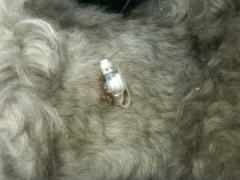Feeding Tubes for Your Pet: What You Need to Know

Feeding Tubes for Your Pet: What You Need to Know
Nutrition is a critical component of successful medical treatment. Malnourished patients don’t heal as quickly after surgery compared to well-nourished ones. In certain diseases, like chronic kidney disease, feeding a particular diet can be life-saving. For pets with chronic kidney disease, feeding a kidney-friendly diet has been shown by scientific research to slow deterioration of kidney function and prolong survival in both dogs and cats.
To provide adequate nutrition in our patients, veterinarians commonly turn to feeding tubes when our patients won’t eat or can’t eat due to an injury or illness. In those pets, which may be difficult to medicate, we place a feeding tube – not for food, but to help the owner give oral medications to a recalcitrant pet.
E-tube
The most common type of feeding tube used at The AMC (and probably at every other veterinary hospital) is an esophagostomy tube, or e-tube for short. We like it because it can be placed while the pet is under light anesthesia, and placement does not require any special equipment other than a few basic forceps and needle holders found in any surgical pack. These tubes are placed through an incision in the skin and through the thick-walled esophagus. The tube is threaded into the esophagus, but is stopped short of the stomach entrance. The tube is sutured into place and covered by a fashionable, protective collar.
G-tube
Gastrostomy tubes are the second most common feeding tube used at The AMC. These tubes are placed with the patient under general anesthesia. An endoscope is used to inflate the stomach and view the proper location for placement. The tube comes with a sharp, pointy trocar which is pushed through the body wall and then the stomach wall. The tube is secured by an inflatable cuff inside the stomach and a flange on the outside. A bandage covers the insertion site and supports the free end of the tube. If the patient requires a tube on a long-term basis, a short tube may be substituted for the original tube. One of these low profile tubes is shown below.
Good news about feeding tubes
If your veterinarian suggests a feeding tube for your pet, I am sure it will provoke feelings of worry and concern – worry, because your pet is so sick he needs a feeding tube, and concern because you are not sure you can manage such a sick pet at home. The good news is either an e-tube or a g-tube can help your pet maintain weight and receive nutrition essential for recovery. The decision as to which tube to place depends on your pet’s illness and nutritional needs. In a survey of cat owners conducted at The AMC, the cat owners found either tube easy to use and were successful in caring for their cats with either one. The same is true for gastrostomy tubes in dogs.

































